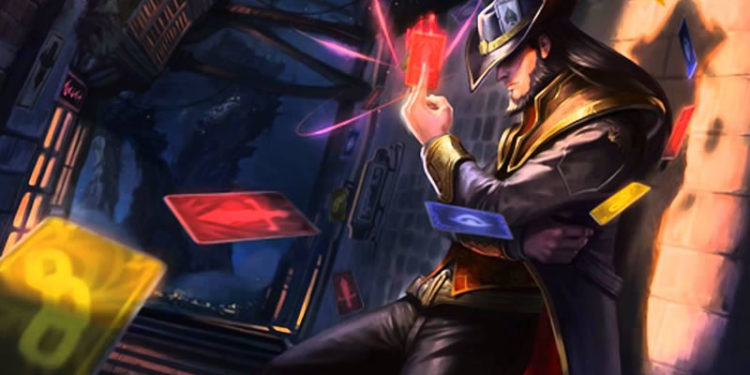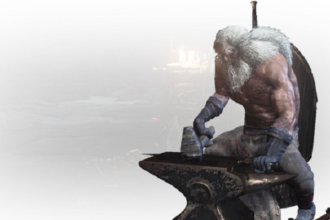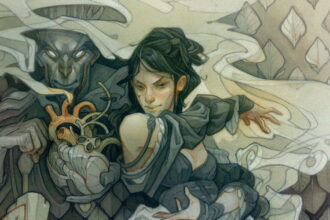Cardslinger Roguish Archetype (D&D 5e)

This week on the Campaign Trail I decided to build out a new archetype for the rogue that would be a good fit for a steampunk, wild west or any setting where people play card games. Playing cards started coming into popularity in Europe during the 14th century, so this archetype would fit the many fantasy game settings that tend to have at least late medieval level technology such as Pathfinder’s Golarion and D&D’s Forgotten Realms.
Cardslinger (Roguish Archetype)
Cardslingers are rogues that depend as much on their agility as their charisma and uncanny abilities with playing cards.
As a cardslinger, your expertise with playing cards goes beyond sleight of hand tricks and winning at the poker table. Cards are weapons in your hands and your skill with them is uncanny. Your abilities allow you to throw cards with deadly accuracy and even infuse them with magic. Each time you draw a card, your connection to the arcane and a little luck allow for the extraordinary and unexpected. With each shuffle of your deck, you come closer to understanding your gift and realizing your true potential.
| Rogue Level |
Feature | Card Tricks Known |
Card Trick Charges |
|---|---|---|---|
| 3rd | Cardsharp, Card Tricks, Card Throwing | 3 | 2 |
| 9th | Magical Cards | 5 | 3 |
| 13th | Counterattack | 7 | 4 |
| 17th | One More Hand | 9 | 5 |
Equipment
Playing card set. 54 cards (4 suits of 13). Each suit (clubs ♣, diamonds ♦, hearts ♥, or spades ♠) contains an Ace, 2, 3, 4, 5, 6, 7, 8, 9, 10, Jack, Queen, and King. There are no duplicates. Additionally, the deck contains two unsuited Jokers.
Cardsharp
When you choose this archetype at 3rd level, you gain proficiency with all gaming sets and expertise with the playing card set.
The class features granted by the roguish archetypes at 3rd level should fundamentally alter the way the class plays. Having a rogue that can use cards to cast magic and as thrown finesse weapons fits that requirement.
Card Tricks
At 3rd level, when you gain this feature, you learn three Card Trick options of your choice.
Once per turn, as an action, you can execute one of your Card Trick options by drawing a card from your deck. You have two uses of this ability, called charges. You regain all expended charges when you shuffle any playing card set during a short or long rest, magically resetting the deck to a full 54 cards.
You gain an additional Card Trick options of your choice and charges when you reach certain levels in this class: 9th, 13th, 17th level.
Card Throwing
At 3rd level, cards are deadly weapons in your hands. You can use cards as simple ranged weapons with the light, finesse, thrown (30/60) properties that deal 1d4 slashing damage on a hit. To throw a card, you must first draw a card from your deck. If you draw a Jack, Queen, King, or Ace you can choose to reroll your damage. If you draw a Joker, you gain back a spent Card Trick charge.
Magical Cards
Starting at 9th level, your cards flow with magical energy and normal thrown card attacks count as magical for the purpose of overcoming resistance and immunity to non-magical attacks and damage. As a bonus action, you can elementally charge a card based on its suit, adding an extra 1d6 damage of that type on a hit. If a card is used for a trick, it loses its elemental charge.
| Card Suit | Damage Type |
|---|---|
| Club | Lightning or thunder |
| Diamond | Cold |
| Heart | Fire |
| Spade | Acid |
Counterattack
Beginning at 13th level, when an enemy misses you or an ally with a melee or ranged attack, you may use your reaction to throw a card at that enemy. If you draw an Ace and you hit on your attack roll, the attack roll should be treated as a critical hit regardless of what the dice roll value was.
You can use this feature a number of times equal to your Charisma modifier (minimum of once), and you regain all expended uses of it when you finish a long rest.
One More Hand
Starting at 17th level, if you roll initiative and have no Card Trick charges remaining, you regain one Card Trick charge.
Card Trick Options
The options are all magical effects. If an option requires a saving throw, your Card Trick save DC equals 8 + your proficiency bonus + your Charisma modifier.
I’ve come up with 11 trick options for this article, but I think it might be nice to choose from up to 15 tricks.
- Acid Burst
You draw a card that starts to disolve and make a ranged card attack against a target. On a hit, the target takes an additional 2d6 acid damage as the cards bursts into acid.
This trick’s acid damage increases by 1d6 when you reach 9th level (3d6), 13th level (4d6), and 17th level (5d6). - Blind Defense
You draw a card that begins to glow bright and make a ranged card attack against a target. On a hit, the creature takes an extra 1d6 radiant damage. The creature must also succeed on a Constitution saving throw, or be blinded until the end of your next turn.
This trick’s radiant damage increases by 1d6 when you reach 9th level (2d6), 13th level (3d6), and 17th level (4d6). - Bluff
You draw a card which appears blurry to everyone else. You can now bluff a humanoid within 30 feet that you can see. It must succeed on a Wisdom saving throw, or it has disadvantage on Insight checks against you for 1 hour.
This trick allows you to target an additional humanoid within 30 feet that you can see when you reach 9th level, 13th level, and 17th level. - Cold Call
You draw a card covered in frost and make a ranged card attack against a target. On a hit, the target takes an additional 2d6 cold damage and its speed is reduced by 10 feet until the start of your next turn.
This trick’s cold damage increases by 1d6 when you reach 9th level (3d6), 13th level (4d6), and 17th level (5d6). - Disguise
You draw a card which transforms into a different card. You can now disguise yourself for 1 hour making yourself, including your clothing, armor, weapons, and other belongings on your person, look different. You can seem 1 foot shorter or taller and can appear thin, fat, or in between. You can’t change your body type, so you must adopt a form that has the same basic arrangement of limbs. Otherwise, the extent of the Illusion is up to you. The changes wrought by this trick fail to hold up to physical inspection. For example, if you use this spell to add a hat to your outfit, Objects pass through the hat, and anyone who touches it would feel nothing or would feel your head and hair. If you use this spell to appear thinner than you are, the hand of someone who reaches out to touch you would bump into you while it was seemingly still in midair. To discern that you are disguised, a creature can use its action to inspect your appearance and must succeed on an Intelligence (Investigation) check.
This trick can disguise an additional creature when you reach 13th level. - Duplicate
You draw a card and tear it in two. This creates a perfect illusory duplicate of yourself that lasts for 1 minute, or until you lose your concentration (as if you were concentrating on a spell). The illusion appears in an unoccupied space that you can see within 30 feet of you. As a bonus action on your turn, you can move the illusion up to 30 feet to a space you can see, but it must remain within 90 feet of you. For the duration, when both you and your illusion are within 5 feet of a creature that can see the illusion, you have advantage on attack rolls against that creature, given how distracting the illusion is to the target.
At 13th level, you can throw cards as though you were in the illusion’s space. - Heater
You draw a card that begins to glow red and make a ranged card attack against a target. On a hit, the card ignites and the target takes an additional 2d6 fire damage. A flammable object hit by this spell ignites if it isn’t being worn or carried.
This trick’s fire damage increases by 1d6 when you reach 9th level (3d6), 13th level (4d6), and 17th level (5d6). - Luck of the Draw
You draw a card and nothing appears to happen. For 1 minute whenever you make an attack roll, an ability check, or a saving throw, you can choose to spend this trick to roll an additional d20 one time. You can choose to use this trick after you roll the die, but before the outcome is determined. You choose which of the d20s is used for the attack roll, ability check, or saving throw.
At 13th level, you can also give this trick’s effect to anyone you can see within 60 feet. - Quick Escape
You draw a card and it turns to mist and you teleport up to 30 feet to an unoccupied space that you can see.
At 13th level, after you teleport you are invisible until the start of your next turn unless you make an attack or cast a spell. Anything you are wearing or carrying is invisible as long as it is on your person. - Shock and Awe
You draw a card that begins to spark with electrical energy and make a ranged card attack against a target. On a hit, lightning springs from the card and the target takes an additional 2d6 lightning damage and it can’t take reactions until the start of its next turn.
This trick’s lightning damage increases by 1d6 when you reach 9th level (3d6), 13th level (4d6), and 17th level (5d6). - Scare Card
You draw a card filled with illusory magic. You fill the mind of a creature you can see within 30 feet with some illusory image of the creatures worst fears. Unless the target succeeds at a Wisdom saving throw it takes 1d6 psychic damage and becomes frightened for 1 minute, or until you lose your concentration (as if you were concentrating on a spell).
This trick deals additional psychic damage when you reach 9th level (2d6), 13th level (3d6), and 17th level (4d6).
If you like rogues with a little magic, check out Nine Magic Items for Rogues. Next week I’m hoping to continue my series on dueling.
Artwork Credit: Twisted Fate, League of Leagends



